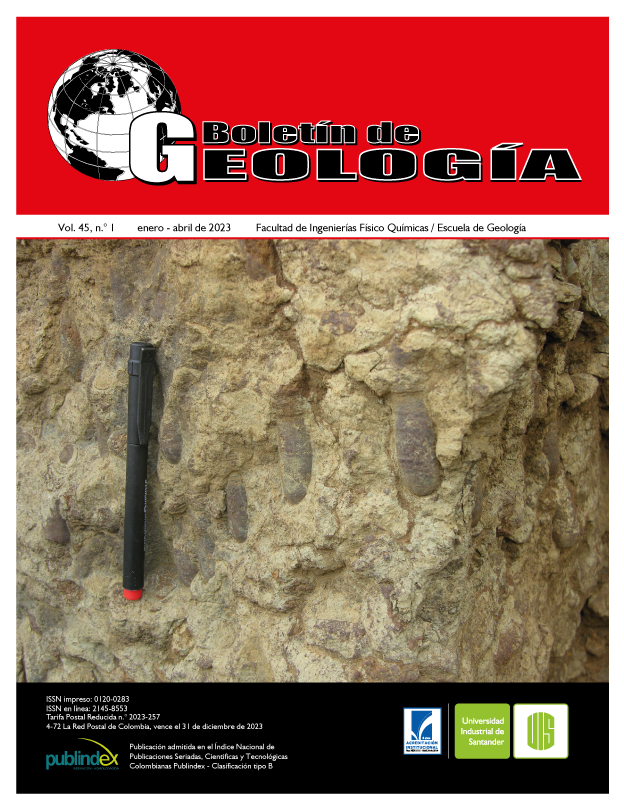Published 2023-02-28
Keywords
- Permeability determination,
- Neural networks,
- Core samples,
- Rock properties,
- Reservoir characterization
- Rock heterogeneity ...More
How to Cite
Copyright (c) 2023 Boletín de Geología

This work is licensed under a Creative Commons Attribution 4.0 International License.
Altmetrics
Abstract
A case study testing the effectiveness of neural networks for permeability determination in heterogeneous media using basic rock properties is presented. The dataset used consists of 213 core samples from the Morrow and Viola formations in Kansas, United States. The characterizing parameters of the cores are porosity (ϕ), water and oil saturations (Sw and So), and grain density (GD), and the additional variables from well logs are induction resistivity (ILD), gamma ray (GR) and neutron-porosity (NPHI). The neural predictions are compared with permeability values obtained from three semi-empirical models (Timur, Coates, and Pape) widely used in reservoir characterization. It is concluded that the neural network provides the best overall prediction quantified by the highest correlation coefficients (R and R2) far above those achieved with conventional methods in formations with rock heterogeneity and complex diagenetic nature. Applying Timur’s method R was 0.58 and R2 was 0.343, for Coates’ model R was 0.60 and R2 0.365 and for Pape’s model R was 0.60 and R2 was 0.372, while for the neural model, 0.97 and 0.94 were obtained for R and R2, respectively.
Downloads
References
- Adams, W. (1964). Diagenetic aspects of lower Morrowan, Pennsylvanian Sandstones, northwestern Oklahoma. AAPG Bulletin, 48(9), 1368-1580. https://doi.org/10.1306/BC743DA1-16BE-11D7-8645000102C1865D
- Aggarwal, C. (2018). Neural networks and deep learning. Springer.
- Al Khalifah, H.; Glover, P.; Lorinczi, P. (2020) Permeability prediction and diagenesis in tight carbonates using machine learning techniques. Marine and Petroleum Geology, 112, 104096. https://doi.org/10.1016/j.marpetgeo.2019.104096
- Bhattacharya, S. (2021). A primer on machine learning in subsurface geosciences. Springer.
- Bornemann, O. (1982). Stratigraphie und tektonik des zechsteins im salzstock gorleben auf grund von Bohrergebnissen. Zeitschrift der Deutschen Geologischen Gesellschaft, 133(2), 119-134. https://doi.org/10.1127/zdgg/133/1982/119
- Caldwell, C.; Boeken, R. (1985). Wireline log zones and core description of upper part of the Middle Ordovician Viola Limestone, McClain and McClain SW fields, Nemaha County, Kansas. Subsurface Geology Series, 6, 17-35.
- Coates, G.; Dumanoir, J. (1973). A new approach to improved Log-Derived permeability. SPWLA 14th Annual Logging Symposium, Lafayette, USA.
- Coates, GR.; Miller, M.; Henderson, G. (1991). The MRIL in Conoco 33-1: an investigation of a new magnetic resonance imaging log. SPWLA 32nd Annual Logging Symposium, Midland, Texas. SPWLA-1991-DD.
- Coolen, C. (1998). A Begginer’s guide to the mathematics of neural networks. King’s College.
- Cranganu, C. (2015). Artificial intelligence approaches in petroleum geosciences. Springer.
- DeVries, A. (2006). Sequence stratigraphy and facies analysis of the Upper Morrow sandstone, Mustang East Field, Morton County, Kansas. AAPG Mid- Continent Section Meeting, Oklahoma City, USA.
- Eriavbe, F.; Okene, U. (2019). Machine learning applications to permeability prediction using log & core measurements: a realistic workflow application for reservoir characterization. SPE Nigeria Annual International Conference and Exhibition, Lagos, Nigeria. https://doi.org/10.2118/198874-MS
- García-Benítez, S.R.; López-Molina, J.A.; Castellanos-Pedroza, V. (2016). Neural networks for defining spatial variation of rock properties in sparsely instrumented media. Boletín de la Sociedad Geológica Mexicana, 68(3), 553-570. https://doi.org/10.18268/BSGM2016v68n3a10
- Goodfellow, I.; Bengio, Y.; Courville, A. (2016). Deep learning. MIT press.
- Habibian, B.; Nabi-Bidhendi, M. (2005). Permeability prediction from wireline logs using artificial neural networks. Journal of the Earth and Space Physics, 31(1), 79-86.
- Helle, H.B.; Bhatt, A.; Ursin, B. (2001). Porosity and permeability prediction from wireline logs using neural networks: a North Sea case study. Geophysical Prospecting, 49(4), 431-444. https://doi.org/10.1046/j.1365-2478.2001.00271.x
- KGS (2020). Kansas Geological Survey - The University of Kansas. http://www.kgs.ku.edu/PRS/petroIndex.html
- Kohli, A.; Arora, P. (2014). Application of artificial neural networks for well logs. International Petroleum Technology Conference, Doha, Qatar. https://doi.org/10.2523/IPTC-17475-MS
- Maslennikova, Y. (2013). Permeability prediction using hybrid neural network modeling. SPE Annual Technical Conference and Exhibition, New Orleans, USA. https://doi.org/10.2118/167640-STU
- Matich, D. (2001). Redes neuronales: conceptos básicos y aplicaciones. Universidad Tecnológica Nacional.
- Mohaghegh, S.; Balan, B.; Ameri, S. (1997). Permeability determination from well log data. SPE Formation Evaluation, 12(3), 170-174. https://doi.org/10.2118/30978-PA
- Pape, H.; Clauser, C.; Iffland, J. (1999). Permeability prediction based on fractal pore-space geometry. Geophysics, 64(5), 1447-1460. https://doi.org/10.1190/1.1444649
- Puckette, J.; Abdalla, A.; Rice, A.; Al-Shaieb, Z. (1996). The Upper Morrow Reservoirs: Complex Fluvio-deltaic Depositional Systems. Oklahoma Geological Survey, 98, 47-84.
- Rascoe, B.; Adler, F. (1983). Permo-carboniferous hydrocarbon accumulations, Mid-continent, USA. AAPG Bulletin, 67(6), 979-1001. https://doi.org/10.1306/03B5B6E1-16D1-11D7-8645000102C1865D
- Rumelhart, D.E.; Hinton, G.E.; Williams, R.J. (1986). Learning representations by back-propagating errors. Nature, 323, 533-536. https://doi.org/10.1038/323533a0
- Saner, S.; Kissami, M.; Al-Naufaili, S. (1997). Estimation of permeability from well logs using resistivity and saturation data. SPE Formation Evaluation, 12(1), 27-31. https://doi.org/10.2118/26277-PA
- Shang, B.Z.; Hamman, J.; Chen, H.; Caldwell, D. (2003). A model to correlate permeability with efficient porosity and irreducible water saturation. SPE Annual Technical Conference and Exhibition, Denver, USA. https://doi.org/10.2118/84303-MS
- Singh, S. (2005). Permeability prediction using artificial neural network (ANN): a case study of Uinta Basin. SPE Annual Technical Conference and Exhibition, Dallas, Texas. https://doi.org/10.2118/99286-STU
- Timur, A. (1968). An investigation of permeability, porosity, and residual water saturation relationship for sandstone reservoirs. The Log Analyst, 9(4). SPWLA-1968-J.

